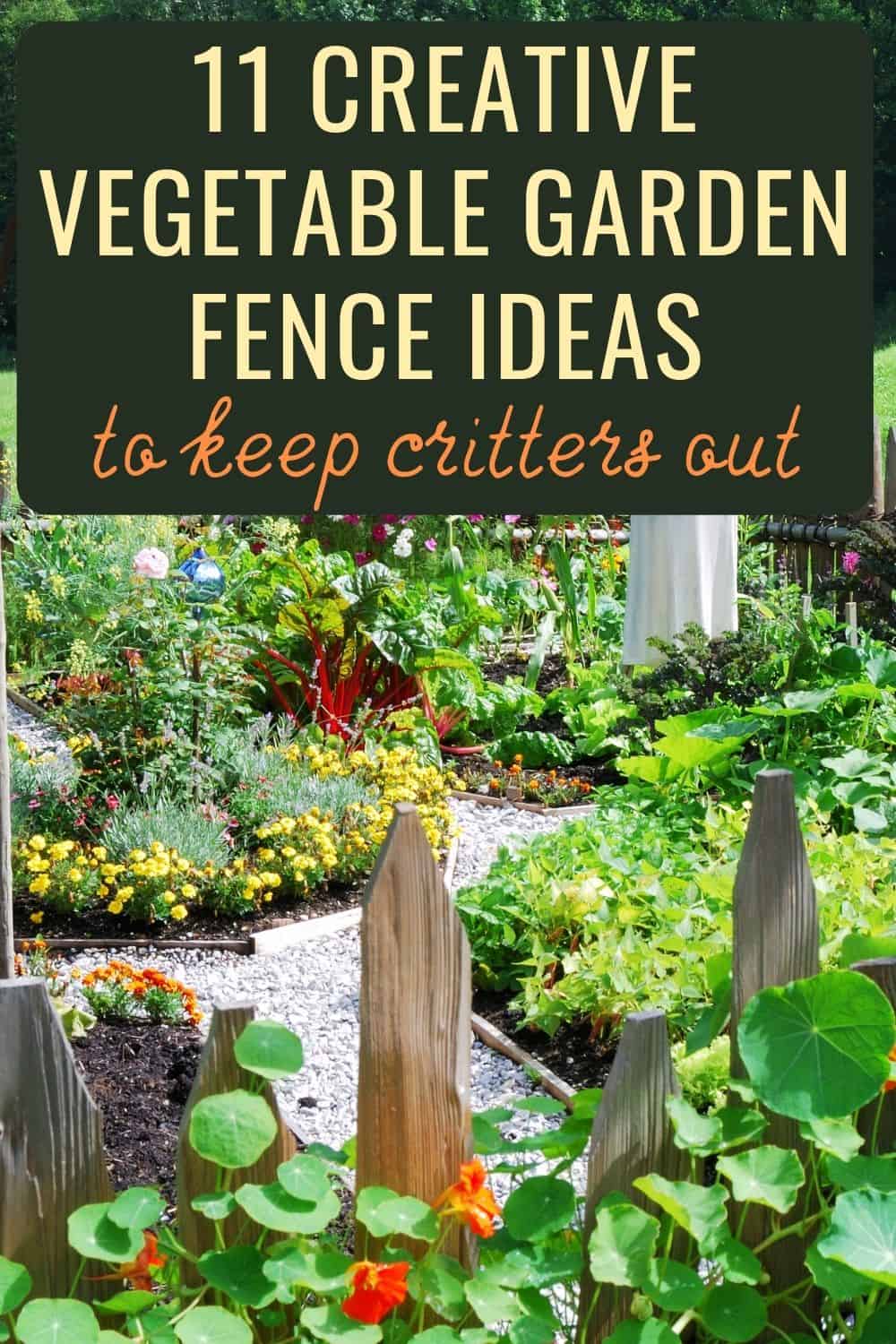If you are planning a garden this spring, there are many furry threats to keep in mind: threats such as rabbits, gophers, groundhogs, and deer that you need to keep out. This guide is going to cover some of the best vegetable garden fence ideas, so you can keep big, as well as smaller critters out and your veggies intact.
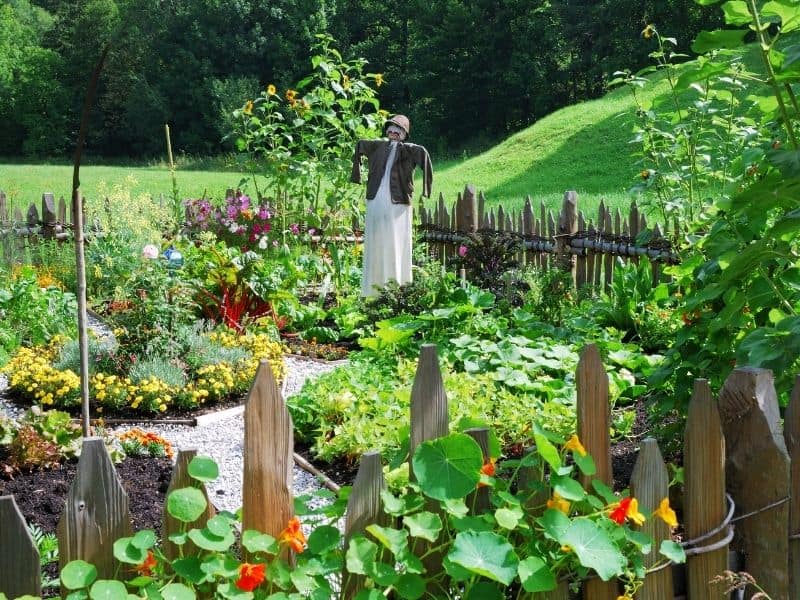
Vegetable Garden Fence Ideas
1. Recycled metal fence

You don’t always have to spend money to protect your garden. Here’s an idea of taking old metal objects no longer in use and create a unique garden fence design.
2. Rolled bamboo fence
A quick and easy way to add a fence to your vegetable garden is to use the rolled bamboo fence. It’s very durable, even though it might seem flimsy at first glance. Properly maintained, it can last up to 20 years, and it has a natural resistance to termites.
Bamboo walls are also great to use as privacy fences: just unroll and install to easily create a secluded spot in your backyard.
3. Wooden and greenery fence
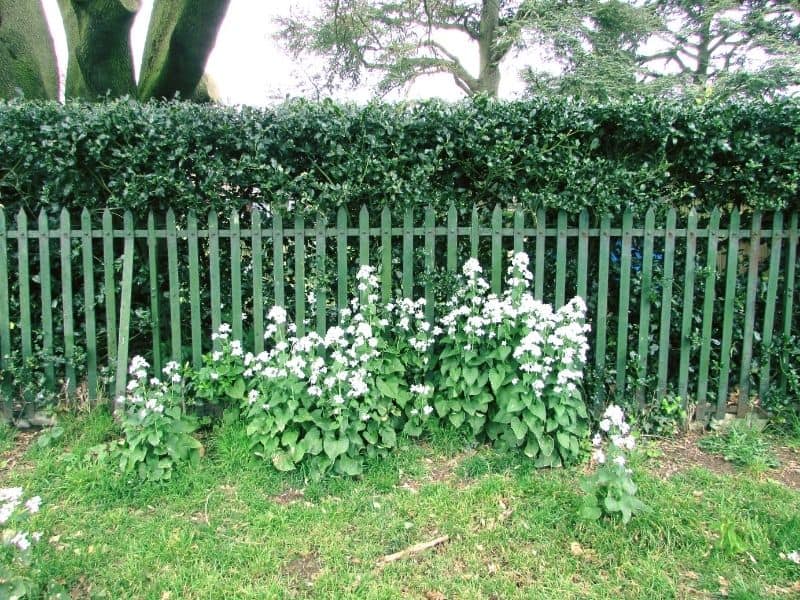
Here’s a small wooden fence “reinforced” by greenery, making it more efficient.
You can take this concept further and create a “fence line” from tepees with pole beans or other vining vegetables, that you intermingle with tall grasses. This creates a beautiful, lush live fence.
4. Patterned wood fence
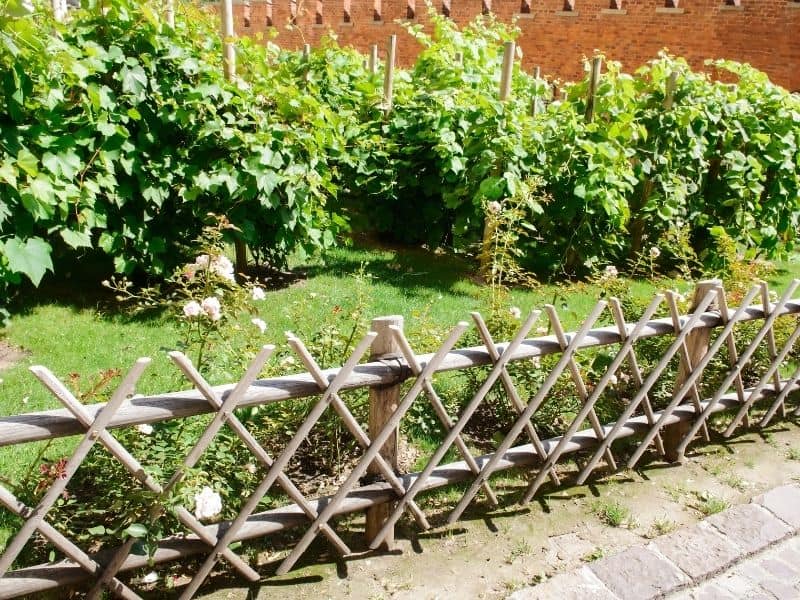
This beautiful patterned wooden fence is for looks only, as it won’t keep anything out. But if you have some crops that are not bothered by pests, this would work really well. Pretty to look at too! Just add some fence posts and create some patterns with different sizes of wood beams
5. Dried brush fence
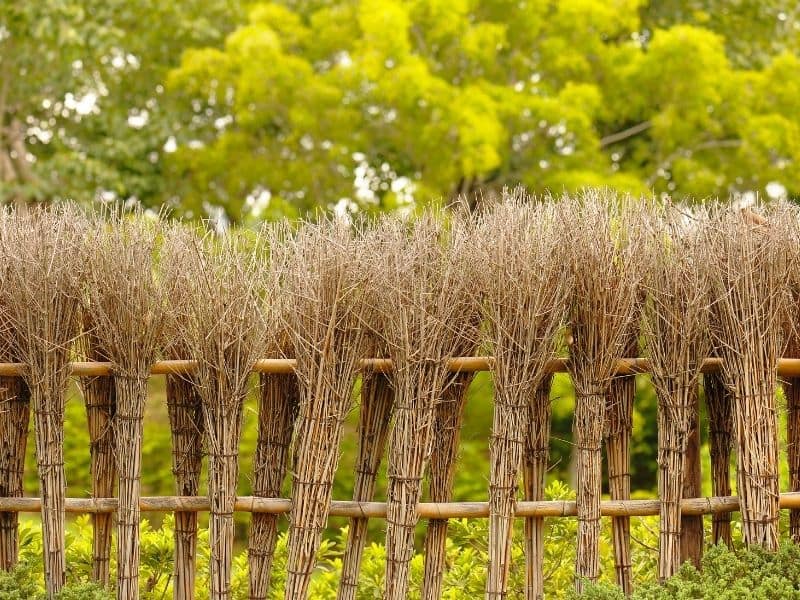
What a neat idea! I love the look of this fence made from dry brush (maybe even some you gathered from the property, as you cleaned up your yard for spring!).
6. Whitewashed wooden fence
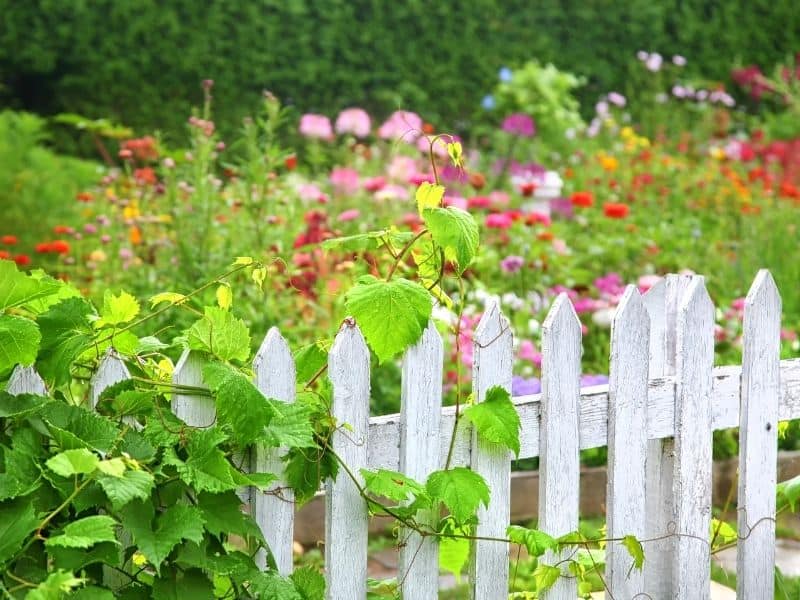
This whitewashed wooden fence creates a cottage feel to your garden. With bright colored flowers in the background, your veggies can be safely tucked away in the background, away from the hungry eyes of garden predators.
If you’d rather have a white picket fence, that looks good too.
7. Colorful recycled wood fence
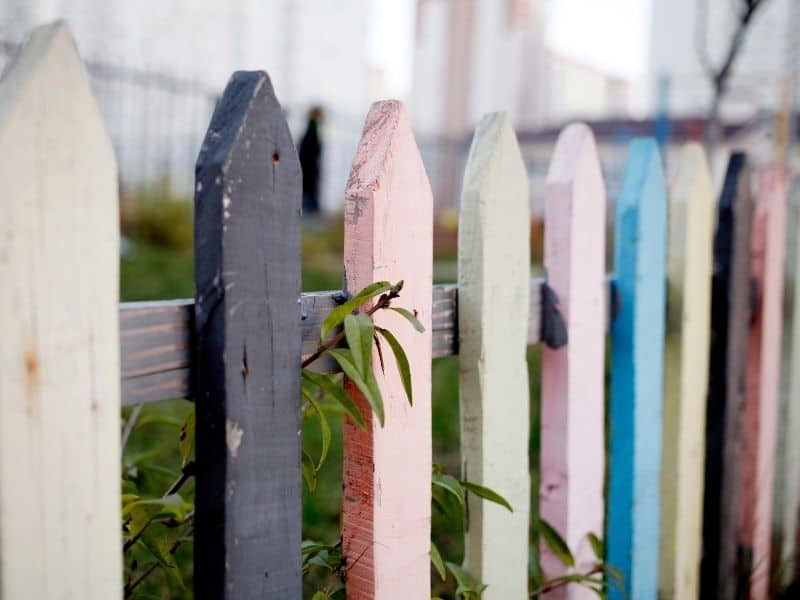
I LOVE using recycled wood for home projects! And this pastel-colored wooden fence is a great idea! If you like DIY projects, and love the earth, creating this fence for your garden will be a very rewarding project that takes little effort.
Invite your children to help: they’ll not only have fun helping paint, but they’ll also learn about recycling and its benefits to our world.
Of course, if you’d rather have a bright-colored fence, go for it. Use different colors for each wood slat for a fun rainbow, or alternate 2 favorite colors. Just have fun with it!
8. White lattice fence
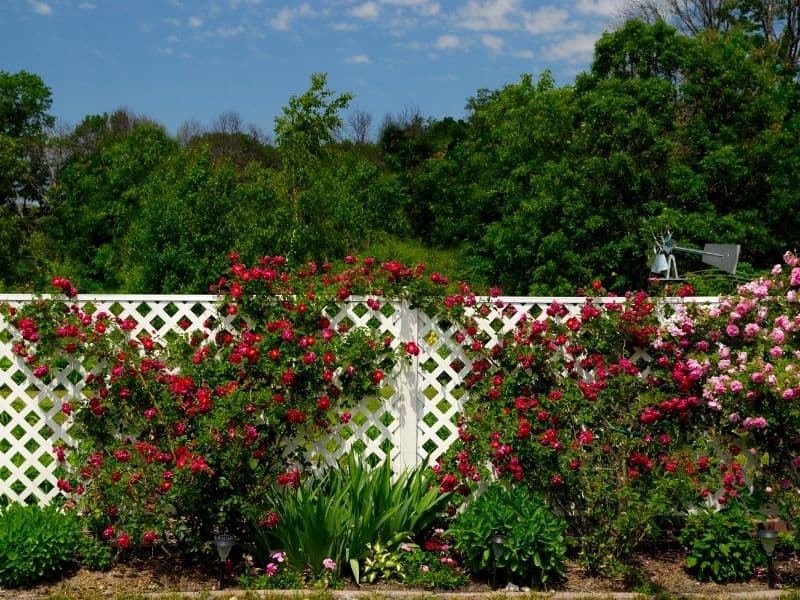
Another pretty to look at fence! And this one is soo easy to install! It won’t be sturdy, but many times you don’t really need a fortress. The white color of the fence is a nice contrast to the red roses and green leaves in this picture. But vegetables would look just as nice behind this fence.
9. Wooden log fence
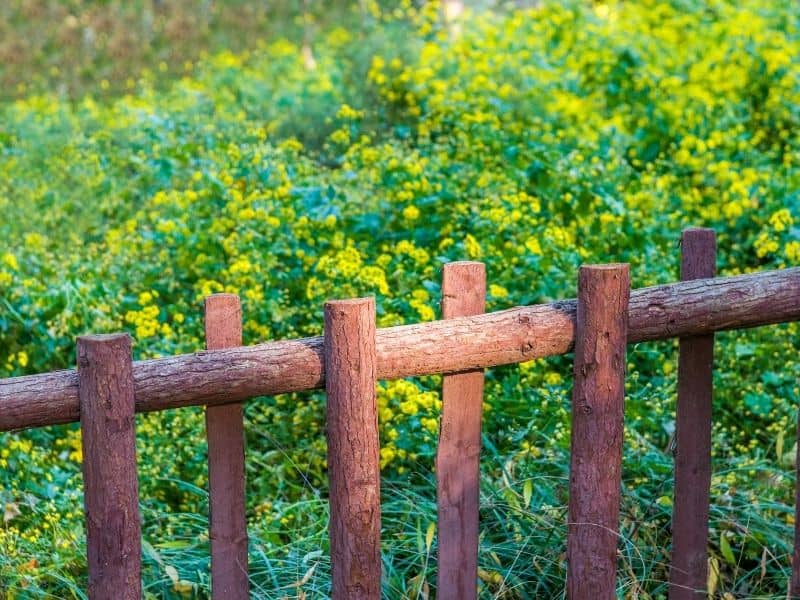
A very simple idea for a DIY garden fence is to make a fence from wooden posts: it makes for a nice addition to your landscape.
10. Wooden fence with metal gate
You will have more success with a wooden fence if you have a metal gate. The reason for this is that wood is naturally a soft product. As it ages, it softens, contracts, and expands. Thereby, the latches and hinges which are attached to the wood eventually lose their once firm hold.
The use of a metal gate will prevent this loosening up of the connections and give you a longer-lasting gate. And, of course, it looks really nice!
11. The modern black fence
This fence design gives your classic garden a flair of modernism. Using a layer of regular chicken wire fencing is a clever way to keep animals, even larger animals out of your garden.
12. Electric fencing
If you don’t really like to put up a visible fence, go with an electric fence. Just make sure to disconnect the power when you need to get in the garden, or you might be regret putting it up.
Why Do I Need a Fence For My Vegetable Garden?
One of the reasons you’d want a vegetable garden fence is for looks. A fenced garden looks more organized, neater, more delimited.
But the more important reason to add a fence to your garden area is to protect your bounty from little creatures that love fresh veggies as much as you do. You aren’t the only one who enjoys a garden full of fresh fruits and vegetables. Lots of small critters are also tempted by a garden. Below are some excellent ideas on how you can reap the fruits of your labor instead of forfeiting it to hungry birds and wild animals.
The most efficient method to keep wild animals out of your garden is, of course, with a fence. If these animal pests are small, like rabbits, then a fence that is 3 feet in height should be sufficient.
However, if it’s deer you are concerned about, then you will require at least a 5 to 7-feet tall fence to keep them out. We live in deer country, and to make sure our veggies are safe, we built an 8-foot fence.
But wait! You have put up a fence, yet, those critters are still finding a way inside your garden. Many wild animals, like rabbits, groundhogs, and gophers can get into your garden by digging UNDER that very efficient fence. If you have these in your area, you might want to put some hardware cloth at the bottom of the fence and also at the bottom of your raised beds.
What animals are eating my garden?
The best way to learn what animals you’re dealing with is to check for the prints they leave behind. Listed below are some hints of the type predators are visiting your garden:
- Hoofprints in the soil and signs of nibbling the shrubbery are signs you have deer visiting.
- Tiny paw prints in the soil may signal bunny rabbits are snipping away at your softest, freshest veggie leaves.
- You might have a groundhog visiting your garden if you recognize the damage to leaves, burrows, or pellet droppings. We had a groundhog in our garden last year: it came from the neighbor’s side of the fence, dug a tunnel under the fence and all the way to the middle of our garden, and came out under our bushy tomatoes (we were behind in removing the suckers) that were growing in raised garden beds. We didn’t think to add hardware cloth last year and the groundhogs wreaked havoc in our sweet peppers harvest that were plants in front of the tomatoes.
- Birds are sneaky little pests whom you will rarely see. But you’ll see the effects of them in your garden since they aren’t picky and will eat anything available. In addition, since they fly, no size fence or barrier will keep them out.
How to Keep Animals out Without a Fence
Fences are nice, but not always a possibility. And while adding a fence to your garden might not be feasible at the moment, you’ll still need to figure out how to keep animals out of the garden.
Create a natural barrier
One way to deter these critters without a fence is to grow a border of plants they dislike. Grow some vegetation around your garden that has a barbed or furry feeling, or an acrid scent. Some plants such as the Osage Orange Tree, make excellent borders to ward off unwanted guests.
Spread coffee ground around your plants
Next time you make a pot of coffee, do not throw away the grounds. Instead, put them to use a second time. Coffee grounds act as a natural offensive method to deter unwanted pests. Just strew a little all over the area of each plant, and you’ll no longer see any little animals, bugs, or cats coming around. The best thing about coffee grounds is it also acts as compost and doesn’t harm your plants.
Learn about natural repellents
You might be short on cash and buying in-store repellents is out of the question. Or you dislike the idea of using harsh chemicals because of the potential harm to your small pets or children. We have found some common household natural repellents that are available right in your kitchen!
- use garlic cloves to make a spray for your plants, and critters will turn their noses up
- making a hot pepper spray will stop deer and rabbits from taking a second bite out of your vegetables
- use castor oil to “convince” pests to move on to another food source
Use artificial repellents
Some other ways to ward off your unwelcome garden guests is to use artificial repellents such as:
- Noisemakers
- Ultrasonic sounds
- Chemical sprays (although some people prefer not to use these due to potential harm to pets and children).
Trapping is another way to get rid of garden pests
When you hear the word “trap” often an inhumane image comes to mind, however, there are methods for trapping critters that are not inhumane. These methods simply avert entrance into your garden.
A common, humane trap a lot of gardeners use is the live trap. These traps are made of steel mesh and have doors that are spring-loaded. They lure wild animals inside and trap them. You can then take the trapped animal to a new location, far away from your garden.
Make use of guard pets
Finally, in this last section, we will cover how your pets can come in handy. You can train your pet dog or cat to scare smaller wildlife away from your garden. Dogs can be excellent at chasing off large predators like deer. However, they can become pests themselves because dogs like to dig. They could create a bigger mess themselves in your garden by digging it up!
Having a pet cat is another excellent deterrence of pests like gophers and birds, and they don’t create the digging mess of a dog.
Frequently Asked Questions (FAQ)
Do I need a fence around my vegetable garden?
In most cases, yes. A fence around your garden keeps hungry pests such as rabbits out. Additionally, having a fence surrounding your garden gives it a visual definition. If there aren’t deer threatening your garden you may use inexpensive, yet effective poultry netting.
How high should a vegetable garden fence be?
If there are deer in the area, you will need a fence at least 5 feet high (preferable 7 or 8 feet). Otherwise, a 2-3 feet height is sufficient.
What is a good way to deter animals from my garden?
There are a variety of scents that will repel animals to avoid your garden. Scents such as castor oil, clips of garlic, and even the urine of predators work as a provisional fix. However, in order to continue its effectiveness, it needs to be continuously monitored. Additionally, you can deter rabbits by using products that have hot peppers in the contents.
What type of fence lasts the longest?
One of the sturdiest and longest-lasting fence materials is masonry. Fences made from concrete, brick, block, stucco, and stone will last the longest. Masonry fences are known to have longevity in excess of 100 years. Of course, that might be way too much for a garden fence.
What can I plant around my fence line?
Some excellent options to plant along a garden’s fence line include a small flower bed and a few flowering bushes. These blooming plants will add color, give your yard a border and attract the eye’s attention. By planting various species of flowering bushes and plants you can create foliage that has texture and lots of colors.
Which is better PVC or vinyl fence?
PVC is simpler to work with, making it a favorite among contractors. It is also resistant to breakdowns of a chemical or biological nature.
What is an effective, yet cheap garden fence?
The best material for making a simple garden fence is chicken wire or poultry netting. This fence is also excellent for containing small animals such as rabbits, small dogs, and other small breeds of animals. Another cheap way to get a fence is to look for a few pallets and make a wooden pallet fence.
I hope you found an idea or two for the right garden fence to wrap your garden in. These awesome DIY garden fence ideas and garden wall ideas should inspire you and help you keep your lush vegetable garden producing for you and your family, without having to share with the wildlife.
